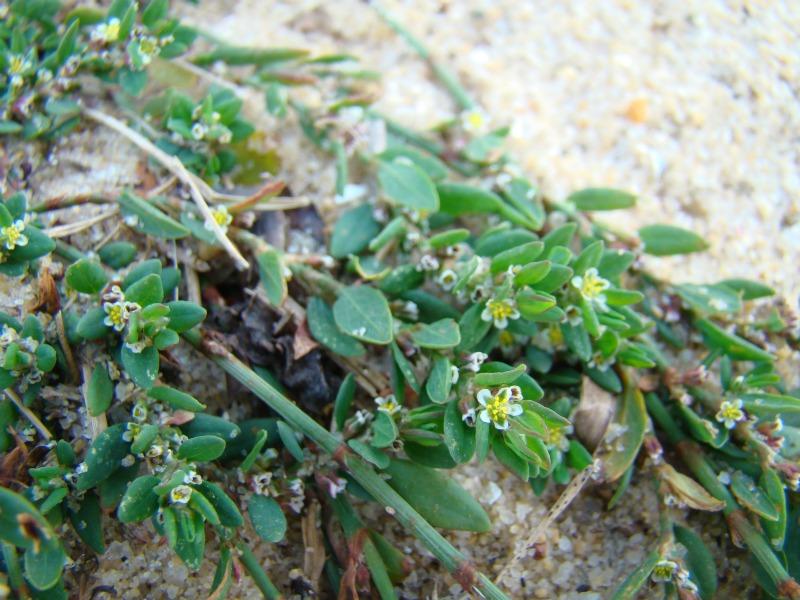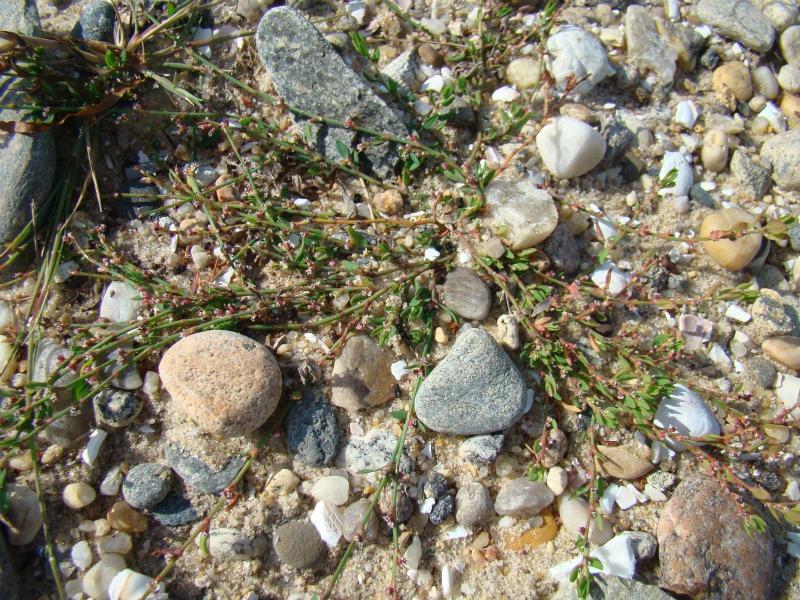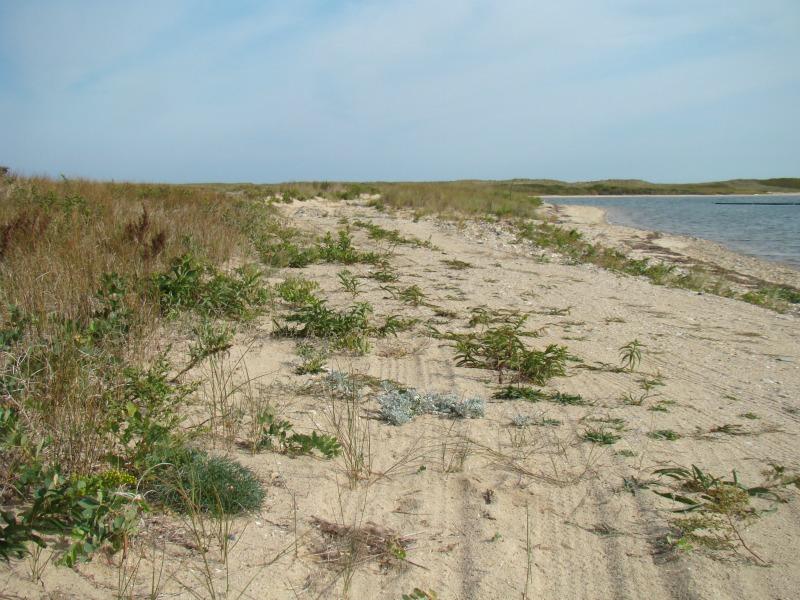American Knotweed
Polygonum buxiforme Small
- Class
- Dicotyledoneae (Dicots)
- Family
- Polygonaceae (Buckwheat Family)
- State Protection
- Endangered
Listed as Endangered by New York State: in imminent danger of extirpation in New York. For animals, taking, importation, transportation, or possession is prohibited, except under license or permit. For plants, removal or damage without the consent of the landowner is prohibited.
- Federal Protection
- Not Listed
- State Conservation Status Rank
- S1S2
Critically Imperiled or Imperiled in New York - Especially or very vulnerable to disappearing from New York due to rarity or other factors; typically 20 or fewer populations or locations in New York, very few individuals, very restricted range, few remaining acres (or miles of stream), and/or steep declines. More information is needed to assign either S1 or S2.
- Global Conservation Status Rank
- G5
Secure globally - Common in the world; widespread and abundant (but may be rare in some parts of its range).
Summary
Did you know?
This plant was formally treated as a full species but the different subspecies of Polygonum aviculare overlap in distinguishing characters and ranges as they have moved into weedy habitats created by humans. The native habitat of this subspecies seems to be beaches and dunes but it is sometimes found in sidewalk cracks, vacant lots, and other weedy places (Flora of North America Editorial Committee 2005).
State Ranking Justification
There are five existing populations but only one of them has more than 100 plants, the rest are very small. There are 17 records from the early 1900s through 1976 which need to be rechecked although one of them is probably gone because of development.
Short-term Trends
Only one population has been visited more than once and its numbers fluctuate depending upon the amount of disturbance on the beach.
Long-term Trends
This species seems to have been more common in the early 1900s but it has declined to only 5 populations today.
Conservation and Management
Threats
Beach populations have been trampled by fishermen and sunbathers which has prevented expansion of populations into a larger area.
Conservation Strategies and Management Practices
Disturbance regimes need to be maintained.
Research Needs
Research is needed to evaluate the kind and interval of disturbance that provides the best habitat for this plant. Seed bank studies could also be done to evaluate how long it persists between disturbance.
Habitat
Habitat
In New York Small's Knotweed occurs mainly on sandy (sometimes also pebbly or gravelly) beaches in both maritime and inland areas. It also has been found on areas of disturbed, compacted soils such as railroad yards and old roads (New York Natural Heritage Program 2011). Packed, non-drifting sands, borders of marshes and dunes, and sandy soils, both maritime and inland (Gleason and Cronquist 1991). Packed, non-drifting sands, dune and marsh borders and inland sandy soils (Mitchell and Deam 1978).
Associated Ecological Communities
- Cobble shore*
(guide)
A community that occurs on the well-drained cobble shores of lakes and streams. These shores are usually associated with high-energy waters (such as high-gradient streams), and they are likely to be scoured by floods or winter ice floes.
- Great Lakes dunes*
(guide)
A community dominated by grasses and shrubs that occurs on active and stabilized sand dunes along the shores of the Great Lakes. Unstable dunes are sparsely vegetated, whereas the vegetation of stable dunes is more dense, and can eventually become forested.
- Inland non-calcareous lake shore
The gravelly, sandy or muddy shore of an inland lake or pond with seasonally fluctuating water levels where the water is not calcareous. There may be few plants and those that are present are usually herbaceous.
- Maritime beach
(guide)
A community with extremely sparse vegetation that occurs on unstable sand, gravel, or cobble ocean shores above mean high tide, where the shore is modified by storm waves and wind erosion.
- Maritime dunes
(guide)
A community dominated by grasses and low shrubs that occurs on active and stabilized dunes along the Atlantic coast. The composition and structure of the vegetation is variable depending on stability of the dunes, amounts of sand deposition and erosion, and distance from the ocean.
- Riverside sand/gravel bar*
(guide)
A meadow community that occurs on sand and gravel bars deposited within, or adjacent to, a river channel. The community may be very sparsely vegetated, depending on the rates of deposition and erosion of the sand or gravel.
- Sand beach
A sparsely vegetated community that occurs on unstable sandy shores of large freshwater lakes, where the shore is formed and continually modified by wave action and wind erosion. Characteristic species that are usually present at very low percent cover include various grasses and other herbs.
* probable association but not confirmed.
Associated Species
- Cakile edentula
- Chamaesyce polygonifolia
- Chenopodium album (lamb's-quarters, pigweed)
- Equisetum arvense (field horsetail, common horsetail)
- Medicago sativa (alfalfa)
- Plantago major (common plantain)
- Polygonum glaucum (sea-beach knotweed)
- Salsola kali
- Solidago sempervirens (northern seaside goldenrod)
Range
New York State Distribution
This low herb is scattered throughout New York in natural and human-disturbed dry open habitats. Most populations are restricted to the rocky beach areas of far eastern Long Island. Many upstate records are from roadsides, fields and railroad yards. More work is needed to determine its true native range.
Global Distribution
It is widespread across the United States and Canada but absent from most of the states of the Southeastern Atlantic and Gulf Coasts.
Identification Comments
General Description
Small's Knotweed is an bluish or grayish green annual herb, growing up to 15 centimeters tall, if erect, or up to 70 centimeters long, if prostrate. A characteristic of all Polygonum species is that their stipules are united to form a sheath around the stem (called an "ocrea") at each node. In this species the ocrea is 3.5 to 6.5 millimeters long. The leaves are 6 to 30 mm long, with the branch leaves up to 2.5 times as long as stem leaves. The flowers are in groups of 2 to 6, each flower with 7 or 8 stamens and 5 tepals. The tepals are 2.3 to 3.4 mm long and green with white or pink margins The outer tepals also have small pouches at their bases. The fruit are dark brown, 3-sided achenes 2-2.8 mm long (late season achenes may reach 5 mm)(FNA 2005).
Best Life Stage for Proper Identification
This species is best identified when flowering or fruiting.
Similar Species
P. glaucum, another species rare in New York, is also usually found on beaches. It differs from Small's Knotweed by having flowers with white, recurved tepals and shiny, smooth, achenes. P. ramosissimum ssp. prolificum, a salt marsh species, differs from P. aviculare ssp. buxiforme by having flowers with only 3 stamens and achenes only 1.6 to 2 mm long.
The other four subspecies of Polygonum aviculare which have been collected in the New York lack the small pouches present on the outer tepals of P. aviculare ssp. buxiforme. Polygonum aviculare ssp. buxiforme is the only subspecies native to the state.
Best Time to See
Flowers begins in July and the fruits persist until the first frost.
- Flowering
- Fruiting
The time of year you would expect to find American Knotweed flowering and fruiting in New York.
American Knotweed Images
Taxonomy
American Knotweed
Polygonum buxiforme Small
- Kingdom Plantae
- Phylum Anthophyta
- Class Dicotyledoneae
(Dicots)
- Order Polygonales
- Family Polygonaceae (Buckwheat Family)
- Order Polygonales
- Class Dicotyledoneae
(Dicots)
- Phylum Anthophyta
Additional Common Names
- Knotgrass
- Knotweed
- Small's Knotweed
Synonyms
- Polygonum aviculare L. [in part.]
- Polygonum aviculare ssp. buxiforme (Small) Costea & Tardif
- Polygonum aviculare var. crassifolium Lange
- Polygonum aviculare var. littorale (Link) Mert.
- Polygonum fowleri B.L. Robins. [Misapplied to New York specimens.]
- Polygonum littorale (Link) Koch
Comments on the Classification
This was changed in the Polygonum volume 5 of Flora North America and the NY Flora Atlas.
Additional Resources
Best Identification Reference
Flora of North America Editorial Committee. 2005. Flora of North America North of Mexico. Vol. 5. Magnoliophyta: Caryophyllidae: Caryophyllales, Polygonales, and Plumbaginales. Oxford Univ. Press, New York. vii + 656 pp.
Other References
Crow, Garrett E. and C. Barre Hellquist. 2000. Aquatic and Wetland Plants of Northeastern North America: A revised and enlarged edition of Norman C. Fassett's a Manual of Aquatic Plants. Volume One: Pteridophytes, Gymnosperms, and Angiosperms: Dicotyledons. The University of Wisconsin Press. Madison, Wisconsin. 536 Pages.
Fernald, M.L. 1950. Gray's manual of botany. 8th edition. D. Van Nostrand, New York. 1632 pp.
Gleason, Henry A. and A. Cronquist. 1991. Manual of Vascular Plants of Northeastern United States and Adjacent Canada. The New York Botanical Garden, Bronx, New York. 910 pp.
Holmgren, Noel. 1998. The Illustrated Companion to Gleason and Cronquist's Manual. Illustrations of the Vascular Plants of Northeastern United States and Adjacent Canada. The New York Botanical Garden, Bronx, New York.
House, Homer D. 1924. Annotated list of the ferns and flowering plants of New York State. New York State Museum Bulletin 254:1-758.
Mitchell, Richard S. and Gordon C. Tucker. 1997. Revised Checklist of New York State Plants. Contributions to a Flora of New York State. Checklist IV. Bulletin No. 490. New York State Museum. Albany, NY. 400 pp.
Mitchell, Richard S. and J. Kenneth Dean. 1978. Polygonaceae (buckwheat family) of New York State. Contributions to a flora of New York State. Richard S. Mitchell, ed. New York State Museum Bulletin No. 431. 79 pp.
New York Natural Heritage Program. 2010. Biotics database. New York Natural Heritage Program. New York State Department of Environmental Conservation. Albany, NY.
New York Natural Heritage Program. 2024. New York Natural Heritage Program Databases. Albany, NY.
Weldy, T. and D. Werier. 2010. New York flora atlas. [S.M. Landry, K.N. Campbell, and L.D. Mabe (original application development), Florida Center for Community Design and Research http://www.fccdr.usf.edu/. University of South Florida http://www.usf.edu/]. New York Flora Association http://newyork.plantatlas.usf.edu/, Albany, New York
Links
About This Guide
This guide was authored by: Richard M. Ring
Information for this guide was last updated on: January 23, 2012
Please cite this page as:
New York Natural Heritage Program. 2024.
Online Conservation Guide for
Polygonum buxiforme.
Available from: https://guides.nynhp.org/smalls-knotweed/.
Accessed July 26, 2024.


